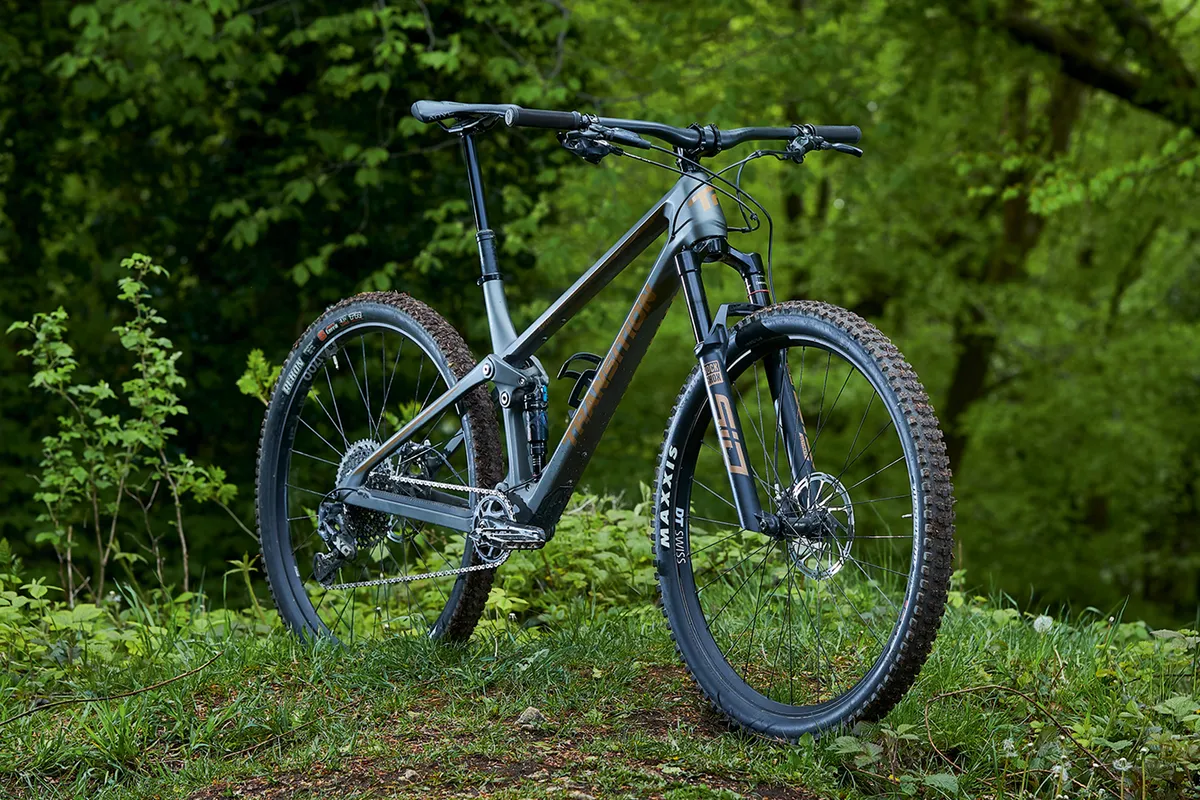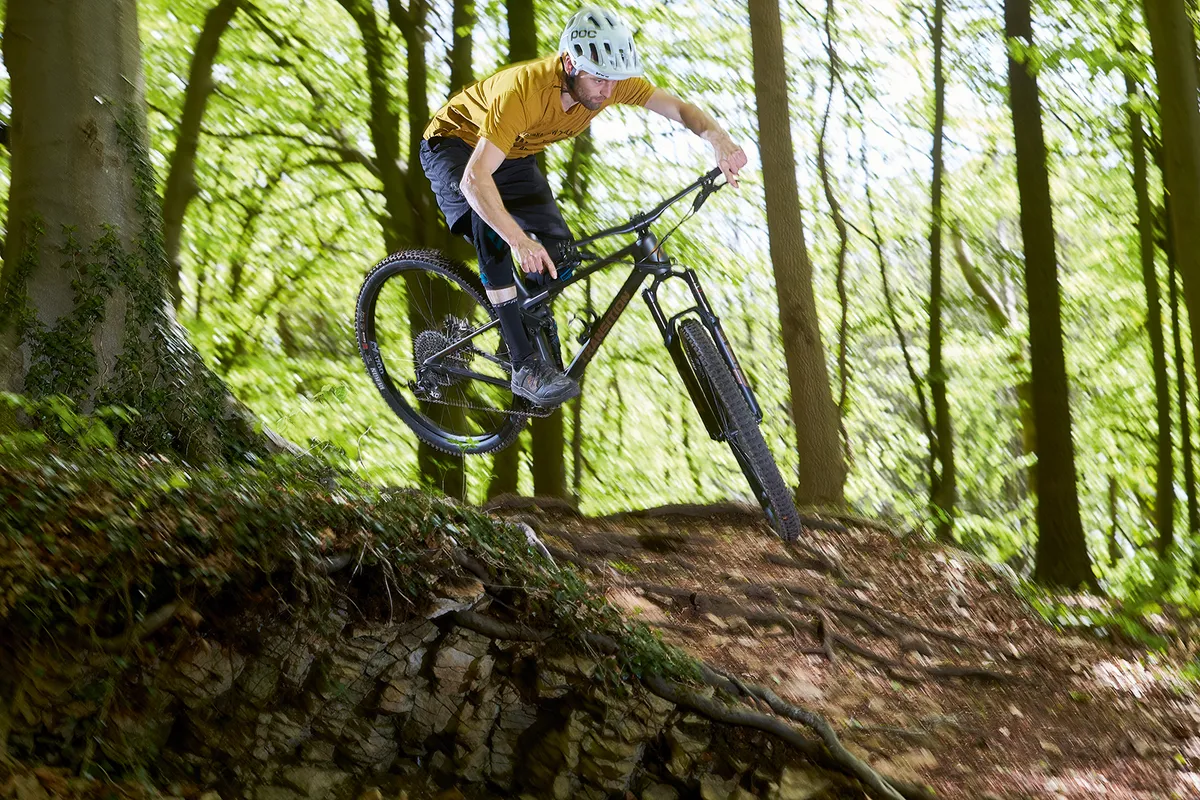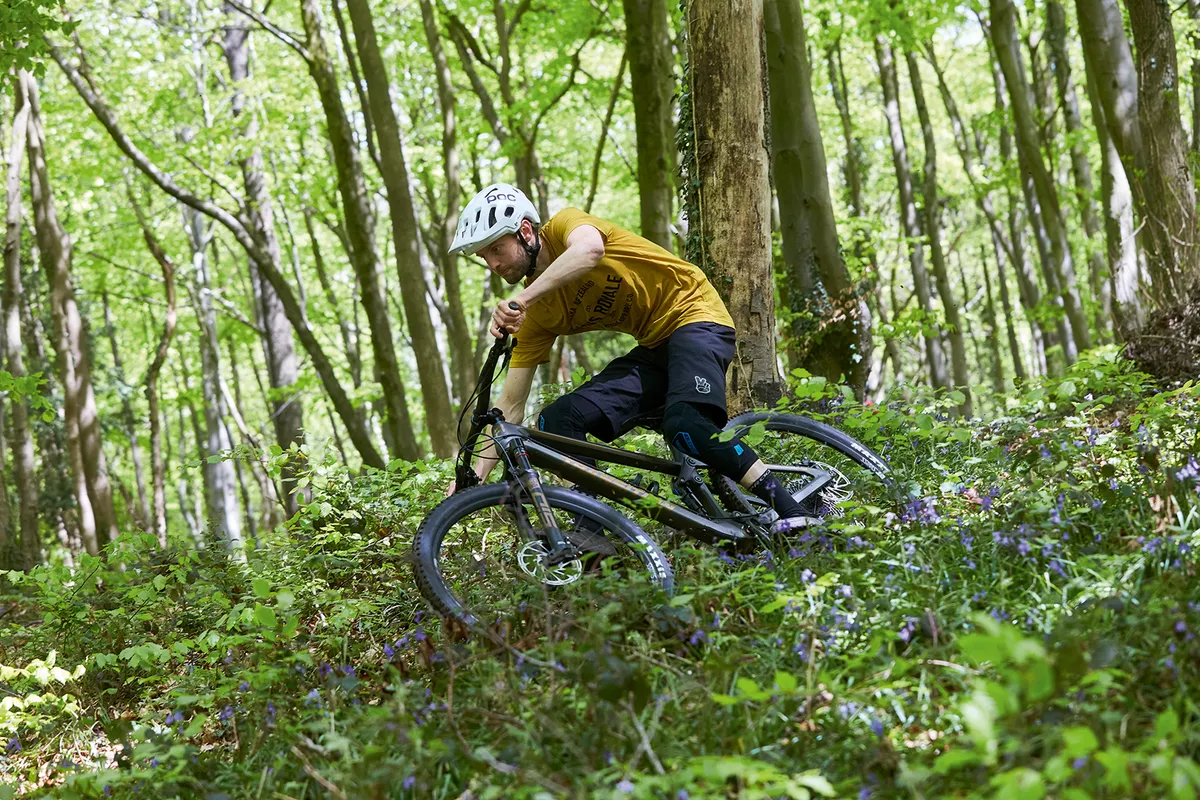Transition’s Spur is its “all-country bike” that’s been designed from the ground up to “effortlessly explore, seek and pursue the mountain in ways you never imagined”.
Unlike a lot of brands, the Spur isn’t built around a pre-existing cross-country bike that’s been beefed up to handle more abuse. Neither is it a pared back trail bike that’s had a host of lighter weight parts bolted to it to make grinding up the hill that bit easier.
No, the Spur has been designed and built specifically to cover ground quickly and efficiently, but not hang around on the downhills either. So does that make it the ultimate all-rounder?
Transition Spur X01 frame and suspension details
Transition only offers the Spur in the full-carbon frame that you see here. At the rear, there’s 120mm of travel which is designed to work with a 120mm travel fork (with a 44mm offset) up front.
To deliver the 120mm of travel, Transition has adapted its tried and trusted GiddyUp to include a one-piece flex stay rear triangle – a design that does away with usual pivot assembly, instead relying upon engineered flex through the rear stays.
This, it claims, has been carefully tuned into the carbon lay-up of the rear triangle to save weight without impacting on frame durability.
If you’d rather a little less travel, Transition says that you can switch to a shorter stroke shock (but with the same eye-to-eye measurement) if you’d prefer just 100mm out back.
Where there are pivots, the Spur uses EnduroMAX bearings which are readily available should you need to replace them at any point.
The straight, almost uninterrupted seat tube allows you to properly slam dropper posts in the frame, meaning you can run a longer drop post and should, in theory, have more than enough bum clearance once the saddle is dropped. My size large frame has a 460mm seat tube and is paired with a 180mm OneUp Components dropper.
Other details include plenty of integrated frame protection, a gear accessory mount (on the underside of the top tube), space for a 750ml water bottle and a lifetime frame warranty.
Transition Spur X01 geometry

Transition offers the Spur in four sizes, ranging from small to extra-large.
The size large test bike I had boasts a generous reach of 480mm (the medium bike has a reach of 460mm which is identical to that of the medium Nukeproof Reactor Carbon 290 ST I also had on test).
I measured the head angle to be a slack 65.9 degrees, which is paired with a 44mm offset fork. The chainstay length is 435mm and I measured the front centre to be 786mm.
To help ensure the Spur feels comfy and efficient on the climbs, the effective seat tube angle is steep, at a shade under 76 degrees.
The bottom bracket sits at just 335mm off the floor (there’s 40mm of drop) which is pretty low.
I’ve already mentioned seat tube length, but it’s worth another word or two. At 460mm for the size large it’s pretty much on par with its closest competitors, though if you look back down the geometry chart, you’ll see that it’s quite a big step down to the medium's 410mm seat tube.
| | S | M | L | XL |
|---|---|---|---|---|
| Seat angle - effective (degrees) | 76.7 | 76.2 | 75.9 | 75.6 |
| Seat angle - actual (degrees) | 72 | 72 | 72 | 72 |
| Head angle (degrees) | 66 | 66 | 66 | 66 |
| Chainstay (cm) | 43.5 | 43.5 | 43.5 | 43.5 |
| Seat tube (cm) | 38 | 41 | 46 | 50 |
| Top tube (cm) | 56.9 | 60.2 | 63 | 66.4 |
| Head tube (cm) | 10 | 11 | 12 | 13.5 |
| Fork offset (cm) | 4.4 | 4.4 | 4.4 | 4.4 |
| Bottom bracket drop (cm) | 4 | 4 | 4 | 4 |
| Bottom bracket height (cm) | 33.5 | 33.5 | 33.5 | 33.5 |
| Wheelbase (mm) | 1,156 | 1,190 | 1,219 | 1,255 |
| Standover (cm) | 66.2 | 66.7 | 67 | 67.7 |
| Stack (cm) | 60 | 61 | 61.9 | 63.2 |
| Reach (cm) | 42.5 | 45.5 | 48 | 51 |
Transition Spur X01 specifications
Just as you’d expect for this sort of cash, the Spur comes with some top-tier kit.
A RockShox SID Ultimate fork is paired with a SIDLuxe Ultimate rear shock. The rebound adjuster at the base of the fork leg is in fact a 2.5mm Allen key, which is a little fiddly to use but okay on the whole.
This can then be unplugged from the underside of the fork and used to adjust the rebound damping on the SIDLuxe shock (which forgoes the usual external adjuster in a bid to save weight).
SRAM provides G2 Ultimate brakes and while Transition puts a 160mm rotor on the rear as standard, I was grateful that my bike, which has clearly seen some use before arriving with me, came with a 180mm rotor instead – a real plus on longer, steeper descents, especially in the wet.
The 12-speed X01 Eagle drivetrain comes courtesy of SRAM too, and features the broad 10-52t cassette along with carbon X1 175mm cranks (the size small uses 170mm crank arms).
Transition has opted to include OneUp Component’s carbon bar which is shaped to help provide a more forgiving ride. OneUp also takes care of the dropper seatpost too, with the massive 180mm drop version adorning my size large test bike.
While some brands will bolt on as much carbon as possible, the Spur doesn’t feature crabon hoops like some (and that’s okay by me). Instead, Transition has specced DT Swiss XR1700 Spline 25 wheels.
These are wrapped in a 2.4in Wide Trail Maxxis Dissector 3C MaxxTerra tyre up front and a speedier 2.4in Wide Trail Rekon Race 3C MaxxTerra at the rear, both of which use the light EXO casing.
Transition Spur X01 ride impressions
I put the Spur through all the types of riding that a bike like this is, at least in my eyes, designed for. That meant laps of beaten-up trail centres as well as flowing bike park style descents littered with jumps.
Then, of course, there was mile after mile of natural singletrack featuring technical climbs and awkward, speed-sapping sections of root-infested trail.
Finally, in a bid to properly push the Spur to its limit, I took on a number of descents that I’d normally reserve for trail bikes with more travel, just to see how confident things felt when the gradient steepened and the bump frequency increased.
In terms of setup, once I’d set the sag on the fork and shock, I never needed to fiddle with the settings and could simply just crack on with the riding.
Transition Spur X01 climbing performance
The Spur might not feel quite as direct under power when compared to Specialized's Epic EVO Expert, but it’s certainly not far off.
Its rear suspension remains calm as you spin the cranks while seated, with very little in the way of bob. When inching up steeper, rough pitches, the rear end does a nice job of remaining active enough to follow each and every bump and lump, eking out more traction than you might expect from the low-treaded Rekon Race rear tyre. There’s plenty of support too, and the bike never feels like it's working against your efforts.
I felt more than comfortable when seated on prolonged uphill drags, and when tackling steep switchbacks I had no issues keeping the front wheel on my intended line, with no hint of lift as I applied the power.

Stand up out of the saddle and the Spur will surge forward enthusiastically as you pile on the watts. This means it’s quick and efficient to power back up to speed if you do need to slow down for a tight turn or technical feature in the trail.
At no point did I feel the need to grab the shock’s lever to firm thing up. Instead, I was able to just get on with the job at hand and let the back end work away, keeping the rear tyre glued to the trail as I clawed my way up the hill.
Transition Spur X01 descending performance
And while the Spur’s uphill performance is really impressive, it’s when pointed downhill that this short travel machine really shines a light on just how capable bikes of this ilk can truly be.
There’s a composure that radiates down the length of the Spur as you bomb into awkward cambered turns or chatter across root spreads. Point the Spur’s front wheel on the line of your choice and it’s incredible just what this bike will handle.
Its innate ability to smooth out the chunder and track the contour of the trail really is impressive for such a short travel machine. Some of this control comes down to the impressive SID fork and SIDLuxe shock combo – both offer a sensitive touch with plenty of control. But there’s no getting away from the fact that Transition has done some sterling work when it comes to how that 120mm of rear-wheel travel is delivered and the feel through the carbon chassis.
At the rear, the initial touch is relatively light and sensitive, but sink further into the shock stroke and there’s more than enough support to help make the Spur nice and reactive when you do want to push back into the bike and make split-second changes of direction. It helps that the low-slung bottom bracket keeps your weight nice and low, boosting stability and confidence.
And while there’s no doubt the Maxxis rubber up front isn’t the fastest rolling tyre out there, it does a great job when it comes to cutting into the dirt, especially in damp conditions. It’s a plus that both tyres feel predictable and consistent over wet rocks and roots too.

When the trail gets rougher and the impacts bigger, the Spur’s gentle ramp up gives the impression that there’s more travel at your disposal, which simply allows you to push the bike that bit harder or ride trickier terrain with more confidence compared to its closest rivals.
On longer descents, having that 180mm rear rotor fitted was noticeable over the other bikes I was testing – two of which feature smaller 160mm rear rotors.
Although the G2 brakes are punchy with a healthy amount of grab, upping the rotor size certainly helps give a much-needed performance boost when dragging your brakes down steeper trails. If you can get your local shop to switch it for you, it’s worth it.
Overall, it’s hard to ignore just how capable the Spur is on both the ups and downs. While it’s more than happy to put the miles in and is by no means a slouch when you’re out of the saddle and piling on the power, its downhill prowess is honestly quite gobsmacking.
Point it down just about any hill and it’ll find its way down the hill in a manner that’ll have you thinking you’ve got more travel at your disposal and leave your mates in a cloud of dust behind you.
Transition Spur X01 bottom line
The Transition Spur is arguably one of the best examples of what a lightweight trail/downcountry bike should be. While it might not feel quite as muscular when you put the power through the pedals as some, it’s still light and eager to get moving, carrying speed with relative ease.
Climbing performance isn’t miles off an XC thoroughbred but it’s the downhill prowess that really grabs the attention: smooth, capable and confident on pretty much any terrain.
It’s an incredible bike with superb geometry, well-considered kit and a ride that’ll put a lot of longer travel bikes to shame on the descents.
How we tested
We put four of the best downcountry mountain bikes through their paces on a range of terrain, which they are designed to handle – including trail centre laps, flowing bike park style descents and jumps, natural singletrack, technical climbs as well as steep, bump-riddled descents – to find out what this burgeoning category of bike is all about.
But what does downcountry mean? Imagine a bike that can tackle all-day epics with speed and efficiency, covering ground with an ease that even a well-put-together trail bike would struggle to muster.
What's more, not only can it eat up the miles, but it's designed in such a way and has the right mix of parts to handle rugged natural singletrack or the odd flowing jump trail with more stability than its limited travel might suggest.
Suspension travel generally sits between 110 and 125mm, and they're fitted with relatively light, fast-rolling tyres on 29in wheels. Dropper posts tend to feature too, for maximum trail flow.
Due to current availability issues, the bikes in our test are top-end builds, or close to it, but if you can't stretch to these lofty price tags there are cheaper models available in most cases – although you may face a wait for one.
Also on test
Product
| Brand | transition |
| Price | 10499.00 AUD,6000.00 GBP,6499.00 USD |
| Weight | 11.7300, KILOGRAM (L) - without pedals |
Features
| Fork | RockShox SID Ultimate, 120mm |
| br_stem | RaceFace Turbine R, 50mm |
| br_chain | SRAM X01 Eagle |
| br_frame | Spur Carbon, 120mm (4.7in) travel |
| Tyres | Maxxis Dissector 3C MaxxTerra EXO 29x2.4in WT (fr), Maxxis Rekon Race 3C MaxxTerra EXO 29x2.4in WT (r) |
| br_brakes | SRAM G2 RSC (180mm/160mm rotors) |
| br_cranks | SRAM X1 Carbon |
| br_saddle | ANVL Forge Ti |
| br_wheels | DT Swiss XR1700 Spline 25 |
| br_shifter | SRAM X01 Eagle |
| br_cassette | SRAM X01 Eagle |
| br_seatpost | OneUp Components, 180mm |
| br_gripsTape | Senus Lite |
| br_handlebar | OneUp Components Carbon, 800mm |
| br_rearShock | RockShox SIDLuxe Ultimate |
| br_bottomBracket | SRAM DUB |
| br_availableSizes | S, M, L, XL |
| br_rearDerailleur | SRAM X01 Eagle |
